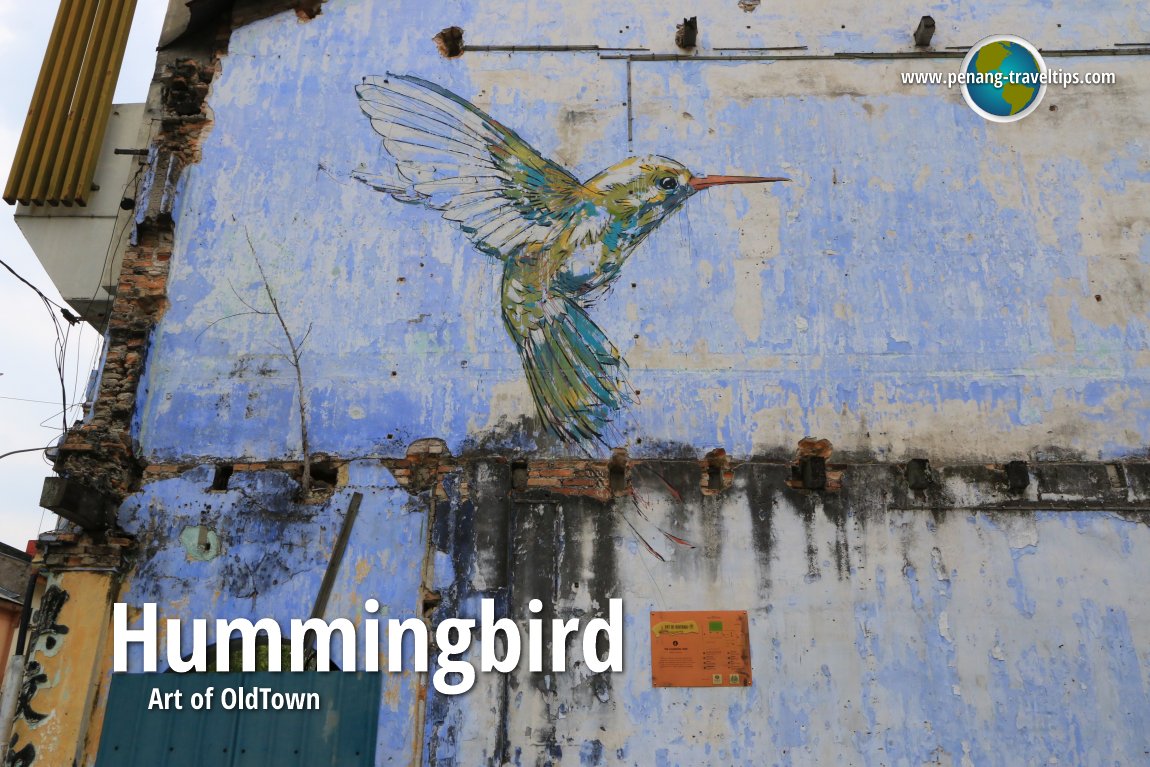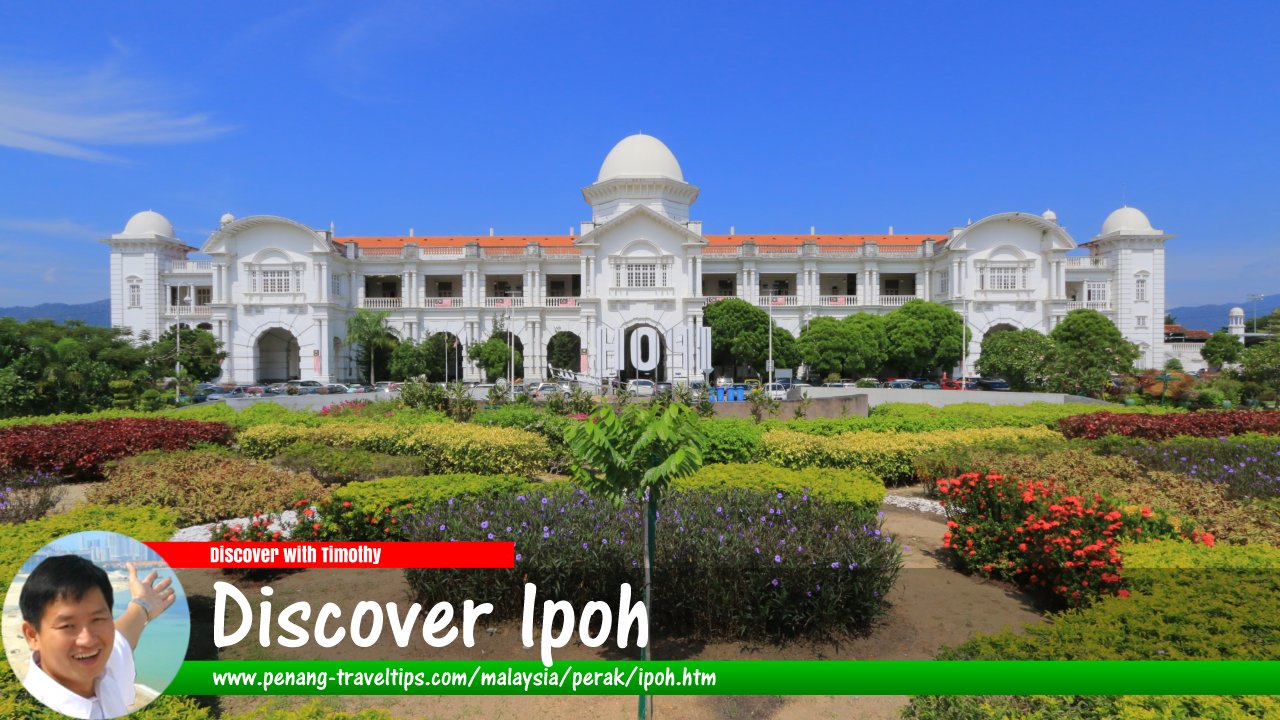 Ipoh Railway Station (19 October, 2018)
Ipoh Railway Station (19 October, 2018)
B. Melayu
Ipoh (Chinese: 怡保, Pinyin: Yíbǎo; GPS: 4.60085, 101.07769) is a medium-size city in Malaysia. It is located between Penang and Kuala Lumpur, it serves as the state capital of Perak. Since being accorded city status, the Ipoh City Council or Dewan Bandaraya Ipoh, includes smaller towns such as Chemor, Jelapang, Falim, Menglembu and Tanjung Rambutan. Historically however, Ipoh referred to the Old Town and New Town, two areas divided by the Kinta River at its heart, from which the city grew.
History of Ipoh
The name Ipoh is said to have come from a tree, the Antiaris toxicaria, which is more commonly known as pokok ipoh (also written ipuh, epu). This plant produces a poisonous sap that is used by the Orang Asli for their blowdarts. The name first appeared in a British map as Epau in 1876.1 Ipoh is also known as San Seng in Chinese, which means "hill city" in the Cantonese. This probably refers to the many limestone outcrops around the city. An old nickname for Ipoh is City of Millionaires, referring to the vast fortunes made during the days of the tin and rubber industry.The city grew out of a settlement known as Kampung Paloh around 1700, populated by Malays and Orang Asli. The name Paloh still exists today, such as in the name of Masjid Paloh. However the expansion of the town only gathered pace when Dato Panglima Kinta Yusuff encouraged inward migration.2
Being in the rich tin-bearing Kinta Valley, Ipoh was a boom town in the 1920s and 30s. When the price of tin collapsed in the 1950s, it resulted in the closure of many Ipoh tin mines, stagnating the growth of the town, and propelled its population to seek employment in other parts of Malaysia. Ipoh has a reputation of being one of the cleanest cities. It is also well known for its clear water supply, which allows it to be a choice producer of vegetables, especially bean sprouts.
Ipoh, like many major towns in Malaysia, has its share of heritage buildings. Unfortunately, a good number of them are today in a run-down state. Some, like the Pasar Bulat, is no longer standing, although it continues to appear on guidebooks. It is my desire to regularly update the information provided to you, so that it remains current and useful.
Map of Ipoh, Perak
List of sights in Ipoh
- AEON Ipoh Falim (GPS: 4.5814, 101.06197)

- AEON Mall Ipoh Station 18 (GPS: 4.54568, 101.07067)

- AEON Mall Ipoh Klebang (GPS: 4.67746, 101.12312)

- Ali Pitchay Townhouse (GPS: 4.59756, 101.07841)

- Ambika Estates Office (GPS: 4.59517, 101.077)

- Balai Polis Pekan Baru (GPS: 4.59754, 101.07215)

- Birch Memorial (GPS: 4.59686, 101.0762)

- Bulatan Sultan Abdul Aziz (GPS: 4.59761, 101.10529)

- Bulatan Sultan Yussuf (GPS: 4.59203, 101.09024)

- Cenotaph (GPS: 4.59756, 101.07428)

- Central Market (GPS: 4.59595, 101.08274)

- Chee Teik Lim Temple (GPS: 4.58445, 101.08172)

- Chennai Potty (GPS: 4.59516, 101.0767)

- Chinese Theatre Hostel (GPS: 4.59646, 101.07786)

- Chua Cheng Bok Building (GPS: 4.59438, 101.08022)

- Chung Thye Phin Building (GPS: 4.59682, 101.07723)

- Church of Our Lady of Lourdes (GPS: 4.60316, 101.06867)

- Church of St John the Divine (GPS: 4.6015, 101.07587)

- Cititel Express (GPS: 4.59881, 101.07847)

- Dato Seri Adika Raja House (GPS: 4.58992, 101.07921)

- Dewan Bandaran Ipoh (GPS: 4.59723, 101.07492)

- Dudjom New Treasure Buddhist Society (GPS: 4.56312, 101.11456)

- Elim Gospel Hall (GPS: 4.59154, 101.08715s)

- Elken Building (GPS: 4.59731, 101.0765)

- Enlightened Heart Temple (GPS: 4.6039, 101.15404)

- Eu Yan Sang Building (GPS: 4.59426, 101.0775)

- FMS Bar & Restaurant (GPS: 4.59866, 101.07807)

- Foong Seong Building (GPS: 4.59578, 101.0811)

- Giant Hypermarket Farlim (GPS: 4.58415, 101.0666)

- Gua Tambun (GPS: 4.60249, 101.13073)


- Gunung Layang-Layang (GPS: 4.64806, 101.15454)

- Gunung Rapat (GPS: 4.55692, 101.12174)

- Gurdwara Sahib Railway Ipoh (GPS: 4.5984, 101.07251)

- Han Chin Pet Soo (GPS: 4.59629, 101.07904)

- Ho Yan Hor Museum (GPS: 4.59634, 101.07905)

- Hong Leong Bank Building (GPS: 4.59723, 101.08186)

- Hospital Raja Permaisuri Bainun (GPS: 4.60407, 101.09014)

- Hotel Excelsior (GPS: 4.59739, 101.08658)

- HSBC Building (GPS: 4.59755, 101.07741)

- Impiana Hotel Ipoh (GPS: 4.590088, 101.094449)

- Indian Muslim Mosque (GPS: 4.6001, 101.0774)

- Ipoh Baptist Church (GPS: 4.59903, 101.08654)

- Ipoh Cenotaph (GPS: 4.59756, 101.07428)

- Ipoh Court House (GPS: 4.59831, 101.07538)

- Ipoh Downtown Hotel (GPS: 4.59633, 101.08625)

- Ipoh Flagpole (GPS: 4.59913, 101.07573)

- Ipoh Multi-Level Car Park (GPS: 4.59711, 101.07631)

- Ipoh Padang (GPS: 4.59922, 101.07674)

- Ipoh Parade (GPS: 4.59606, 101.09012)

- Ipoh Police Headquarters (GPS: 4.59496, 101.07462)

- Ipoh Railway Station (GPS: 4.59611, 101.07396)

- Ipoh Riverfront Park (GPS: 4.59451, 101.07919)

- Ipoh Tourist Information Centre (GPS: 4.59802, 101.076)

- Ipoh Tree (GPS: 4.59708, 101.07398)

- Jalan Sultan Yusuf Heritage Row (GPS: 4.5963, 101.07708)

- Jambatan C.N. Annadurai (GPS: 4.59184, 101.06583)

- Jambatan Sultan Idris Shah (Birch Bridge) (GPS: 6.435766, 100.190755)

- Jambatan Sultan Iskanar (Hugh Low Bridge) (GPS: 4.59438, 101.08022)

- Japanese Counter Espionage Headquarters (GPS: 4.59942, 101.08599)

- Jingang Jing She Temple (GPS: 4.60264, 101.15574)

- Kek Look Seah (GPS: 4.5808, 101.07747)

- Kek Look Tong (GPS: 4.55904, 101.12927)

- Kian Aik Chan (GPS: 4.59563, 101.07932)

Kinta Aerated Water Company(GPS: 4.59328, 101.0769; demolished)
- Kinta Heights (GPS: 4.59238, 101.07738)

- Kompleks Yik Foong (GPS: 4.59708, 101.08134)

- Kwan Yin Temple (GPS: 4.59851, 101.07943)

- Kwang Tung Cemetery (GPS: 4.59911, 101.10803)

- Leong Yew Koh Office (GPS: 4.59714, 101.07709)

- Ling Sen Tong Cave Temple (GPS: 4.56642, 101.11404)

- Loong Thow Ngam Temple (GPS: 4.63214, 101.08794)

- Majuperak Building (GPS: 4.59757, 101.0808)

- Masjid Muhammadiah (GPS: 4.64954, 101.10728)

- Masjid Paloh (GPS: 4.58986, 101.07721)

- Masjid Panglima Kinta (GPS: 4.59342, 101.08063)

- Masjid Sultan Idris Shah II (GPS: 4.59617, 101.07578)

- Masjid Sultan Yussuf (GPS: 4.57121, 101.12528)

McDonalds Ipoh Building(GPS: 4.59567, 101.08305)
- Mekprasit Buddhist Temple (GPS: 4.625, 101.08144)

- Methodist Girls School Ipoh (GPS: 4.58719, 101.08511)

Miniature Wonders Art Gallery(GPS: 4.59589, 101.0783)
Movie Animation Park Studios of Perak(GPS: 4.66475, 101.08402)
- Muzium Darul Ridzuan (GPS: 4.60456, 101.07796)

- Muzium Geologi (GPS: 4.59755, 101.11978)

- Nam Thean Tong Cave Temple (GPS: 4.56589, 101.11442)

- OCBC Bank Building (GPS: 4.59683, 101.07677)

- Old OCBC Bank Building (GPS: 4.59513, 101.07711)

- Pakistani Mosque (GPS: 4.59414, 101.07602)

- Paloh Ku Miao (GPS: 4.59328, 101.0788)

- Pantai Hospital (GPS: 4.60334, 101.11958)

- Perak Ku Kong Chow Kung Wui Association (GPS: 4.596713, 101.078652)

- Perak Tong Cave Temple (GPS: 4.64451, 101.09886)

- Perak Toong Onn Woi Koon (GPS: 4.59418, 101.08596)

- Persatuan Hin Aun Perak (GPS: 4.59707, 101.08623)

- Public Bank Building (GPS: 4.59764, 101.08204)

- Qing Xin Ling Leisure and Cultural Village (GPS: 4.56191, 101.1242)

- Royal Ipoh Club (GPS: 4.59955, 101.07544)

- Rumah Pangsa Jalan Bijih Timah (GPS: 4.59288, 101.07816)

- Sam Poh Tong Cave Temple (GPS: 4.5643, 101.1151)

- Seenivasagam Brothers' Law Office (GPS: 4.59785, 101.07648)

- Sew Cheong Building (GPS: 4.59491, 101.08107)

- Sinhalese Bar (GPS: 4.59558, 101.07869)

- SMK Methodist (Anglo-Chinese School) (GPS: 4.59186, 101.07254)

- SPH De Silva (GPS: 4.59558, 101.07869)

- Sri Maha Karumariamman Muneswarar Temple (Kaka Kovil) (GPS: 4.58611, 101.0659)

- Sree Muneswarar Amman Kovil (GPS: 4.60396, 101.09419)

- St Andrew's Presbyterian Church (GPS: 4.59508, 101.08827)

- St Michael's Church (GPS: 4.59508, 101.08827)

- St Michael's Institution (GPS: 4.60131, 101.07724)

- Standard Charterd Bank Building (GPS: 4.59722, 101.07685)

- Sultan Azlan Shah Airport (GPS: 4.57007, 101.09846)

- Tai Pee Sim Monastery (GPS: 4.58345, 101.09545)

- Taman Rekreasi Gunung Lang (GPS: 4.62744, 101.09055)

- Taman Rekreasi Sultan Abdul Aziz (GPS: 4.5969, 101.11192)

- Tasik Cermin (GPS: 4.55983, 101.11864)


- Tenaga Nasional Building (GPS: 4.59742, 101.07613)

- The Haven Resort Ipoh (GPS: 4.63655, 101.16221)

- The Octagon (GPS: 4.59452, 101.08543)

- The Store Jalan Kampar (GPS: 4.58396, 101.09079)

- Tower Regency Hotel (GPS: 4.60039, 101.0879)

- Time Tunnel (GPS: 4.59675, 101.07825)

- Traditional Stovemakers (GPS: 4.62058, 101.07856)

- Travelodge Ipoh (GPS: 4.62058, 101.07856)


- True Jesus Church (GPS: 4.60065, 101.08701)

- Tung Wah Tong (GPS: 4.64439, 101.15573)

- UTC Perak (GPS: 4.59578, 101.08219)

- Wan Muhammad Saleh Mausoleum (GPS: 4.58996, 101.07676)

- Warta Kinta Office (GPS: 4.58976, 101.07766)

- Wat Puthanimittam (GPS: 4.58976, 101.07766)

- Yau Tet Shin Mansion (GPS: 4.59296, 101.07451)

Chinese/Buddhist Temples and Monasteries in Ipoh
- Chee Teik Lim Temple (GPS: 4.58445, 101.08172)

- Dudjom New Treasure Buddhist Society (GPS: 4.56312, 101.11456)

- Enlightened Heart Temple (GPS: 4.6039, 101.15404)

- Jingang Jing She Temple (GPS: 4.60264, 101.15574)

- Kek Look Seah (GPS: 4.5808, 101.07747)

- Kek Look Tong (GPS: 4.55904, 101.12927)

- Kwan Yin Temple (GPS: 4.59851, 101.07943)

- Ling Sen Tong Cave Temple (GPS: 4.56642, 101.11404)

- Loong Thow Ngam Temple (GPS: 4.63214, 101.08794)

- Mekprasit Buddhist Temple (GPS: 4.625, 101.08144)

- Nam Thean Tong Cave Temple (GPS: 4.56589, 101.11442)

- Paloh Ku Miao (GPS: 4.59328, 101.0788)

- Perak Tong Cave Temple (GPS: 4.64451, 101.09886)

- Sam Poh Tong Cave Temple (GPS: 4.5643, 101.1151)

- Tai Pee Sim Monastery (GPS: 4.58345, 101.09545)

- Tung Wah Tong (GPS: 4.64439, 101.15573)

- Wat Puthanimittam (GPS: 4.58976, 101.07766)

- Wat Siribunyamagaram (GPS: 4.60114, 101.11438)

- WEIL Hotel (GPS: 4.59469, 101.09007)

Government Buildings in Ipoh
- Dewan Bandaran Ipoh (GPS: 4.59723, 101.07492)

- Ipoh Police Headquarters (GPS: 4.59496, 101.07462)

- Ipoh Tourist Information Centre (GPS: 4.59802, 101.076)

- UTC Perak (GPS: 4.59578, 101.08219)

Historic buildings in Ipoh
- Ali Pitchay Townhouse (GPS: 4.59756, 101.07841)

- Ambika Estates Office (GPS: 4.59517, 101.077)

- Chennai Potty (GPS: 4.59516, 101.0767)

- Chinese Theatre Hostel (GPS: 4.59646, 101.07786)

- Chua Cheng Bok Building (GPS: 4.59438, 101.08022)

- Chung Thye Phin Building (GPS: 4.59682, 101.07723)

- Dato Seri Adika Raja House (GPS: 4.58992, 101.07921)

- Elken Building (GPS: 4.59731, 101.0765)

- Eu Yan Sang Building (GPS: 4.59426, 101.0775)

- FMS Bar & Restaurant (GPS: 4.59866, 101.07807)

- Foong Seong Building (GPS: 4.59578, 101.0811)

- Han Chin Pet Soo (GPS: 4.59629, 101.07904)

- Ho Yan Hor Museum (GPS: 4.59634, 101.07905)

- HSBC Building (GPS: 4.59755, 101.07741)

- Ipoh Court House (GPS: 4.59831, 101.07538)

- Jalan Sultan Yusuf Heritage Row (GPS: 4.5963, 101.07708)

- Japanese Counter Espionage Headquarters (GPS: 4.59942, 101.08599)

- Kian Aik Chan (GPS: 4.59563, 101.07932)

Kinta Aerated Water Company(GPS: 4.59328, 101.0769; demolished)
- Leong Yew Koh Office (GPS: 4.59714, 101.07709)

- Majuperak Building (GPS: 4.59757, 101.0808)

McDonalds Ipoh(GPS: 4.59567, 101.08305)
- OCBC Bank Building (GPS: 4.59683, 101.07677)

- Old OCBC Bank Building (GPS: 4.59513, 101.07711)

- Perak Ku Kong Chow Kung Wui Association (GPS: 4.596713, 101.078652)

- Public Bank Building (GPS: 4.59764, 101.08204)

- Royal Ipoh Club (GPS: 4.59955, 101.07544)

- Seenivasagam Brothers' Law Office (GPS: 4.59785, 101.07648)

- Sew Cheong Building (GPS: 4.59491, 101.08107)

- Sinhalese Bar (GPS: 4.59558, 101.07869)

- SPH De Silva (GPS: 4.59558, 101.07869)

- Standard Charterd Bank Building (GPS: 4.59722, 101.07685)

- Tenaga Nasional Building (GPS: 4.59742, 101.07613)

- Wan Muhammad Saleh Mausoleum (GPS: 4.58996, 101.07676)

- Warta Kinta Office (GPS: 4.58976, 101.07766)

- Yau Tet Shin Mansion (GPS: 4.59296, 101.07451)

Hospitals in Ipoh
- Hospital Raja Permaisuri Bainun (GPS: 4.60407, 101.09014)

- Pantai Hospital (GPS: 4.60334, 101.11958)

Hotels in Ipoh
- Cititel Express (GPS: 4.59881, 101.07847)

- Hotel Excelsior (GPS: 4.59739, 101.08658)

- Impiana Hotel Ipoh (GPS: 4.590088, 101.094449)

- The Haven Resort Ipoh (GPS: 4.63655, 101.16221)

- Tower Regency Hotel (GPS: 4.60039, 101.0879)

Mosques in Ipoh
- Indian Muslim Mosque (GPS: 4.6001, 101.0774)

- Masjid Muhammadiah (GPS: 4.64954, 101.10728)

- Masjid Paloh (GPS: 4.58986, 101.07721)

- Masjid Panglima Kinta (GPS: 4.59342, 101.08063)

- Masjid Sultan Idris Shah II (GPS: 4.59617, 101.07578)

- Masjid Sultan Yussuf (GPS: 4.57121, 101.12528)

- Pakistani Mosque (GPS: 4.59414, 101.07602)

Shopping Malls in Ipoh
- AEON Ipoh Falim (GPS: 4.5814, 101.06197)

- AEON Mall Ipoh Station 18 (GPS: 4.54568, 101.07067)

- AEON Mall Ipoh Klebang (GPS: 4.67746, 101.12312)

- Giant Hypermarket Farlim (GPS: 4.58415, 101.0666)

- Ipoh Parade (GPS: 4.59606, 101.09012)

- The Store Jalan Kampar (GPS: 4.58396, 101.09079)

Map of places to eat in Ipoh
Places to eat in Ipoh
- Ayam Garam Aun Kheng Lim (GPS: 4.59467, 101.08331)

- Canning Garden Bak Kut Teh (GPS: 4.60252, 101.10982)


- Choong Kee Pasir Pinji Big Tree Yong Tau Foo / Restoran Choong Kee Pokok Besar (GPS: 4.58237, 101.08574)

- CT Cendol Corner (GPS: 4.5957, 101.08362)

- Hong Kee Mah Chee Creamy Peanut Dessert (GPS: 4.57302, 101.08698)

- Kedai Kopi Loke Wooi Kee (GPS: 4.5951, 101.08348)

- Kedai Kopi Woh Heng (GPS: 4.59523, 101.08433)

- Kedai Minuman & Makanan Hua Nam (GPS: 4.59693, 101.08562)

- Medan Selera Dato' Tahwil Azar (GPS: 4.596, 101.08402)

- Ming Court Hong Kong Tim Sum (GPS: 4.59708, 101.08632)

- Nasi Ganja (GPS: 4.59268, 101.0847)

- Restoran Chang Keong Dim Sum (GPS: 4.59722, 101.08574)

- Restoran Foh San (GPS: 4.59694, 101.08583)

- Restoran Haji Yahya (GPS: 4.59434, 101.08242)

- Restoran Ipoh Kong Heng (GPS: 4.59646, 101.07786)

- Restoran Lou Wong Beansprout Chicken (GPS: 4.59396, 101.0842)

- Restoran Ong Kee Beansprout Chicken (GPS: 4.59384, 101.08388)

- Restoran Sin Lean Lee (Kin Kwok Daily News Building) (GPS: 4.59677, 101.07818)

- Tai Soo Ipoh Famous No. 1 Dessert Shop (GPS: 4.57214, 101.11504)

- Yong tau foo at Kedai Kopi Kwong Hong (GPS: 4.57214, 101.11504)

Map of things to buy in Ipoh
What to buy in Ipoh
- Pomelos - Ah Sai Fruits Trading (GPS: 4.61021, 101.1396)

- Teochew Soft Candy - Ching Han Guan Biscuit Shop (GPS: 4.59354, 101.08367)

- Traditional Biscuits - 362 Gunung Rapat Heong Peah (GPS: 4.574333, 101,120056), 362 Jalan Gunung Rapat

- Traditional Biscuits - Biskut Yee Thye, Jalan Dato Tahwil Azar Branch (GPS: 4.5944, 101.08431)

Neighbourhoods and Townships of Ipoh
- Bandar Meru Raya (GPS: 4.66959, 101.07872)

- Canning Garden
- Falim
- Ipoh Old Town
- Ipoh New Town
Hindu Temples in Ipoh
- Arulmigu Maha Ganapathy Aalayam (GPS: 4.59754, 101.07215)

- Sri Maha Karumariamman Muneswarar Temple (Kaka Kovil) (GPS: 4.58611, 101.0659)

- Sree Muneswarar Amman Kovil (GPS: 4.60396, 101.09419)

Churches in Ipoh
- Church of Our Lady of Lourdes (GPS: 4.60316, 101.06867)

- Church of St John the Divine (GPS: 4.6015, 101.07587)

- Ipoh Baptist Church (GPS: 4.59903, 101.08654)

- St Andrew's Presbyterian Church (GPS: 4.59508, 101.08827)

- St Michael's Church (GPS: 4.59508, 101.08827)

- True Jesus Church (GPS: 4.60065, 101.08701)

Gurdwaras in Ipoh
- Gurdwara Sahib Railway Ipoh (GPS: 4.5984, 101.07251)

Monuments in Ipoh
- Birch Memorial (GPS: 4.59686, 101.0762)

- Cenotaph (GPS: 4.59756, 101.07428)

Bridges in Ipoh
- Jambatan C.N. Annadurai (GPS: 4.59184, 101.06583)

- Jambatan Sultan Idris Shah (Birch Bridge) (GPS: 6.435766, 100.190755)

- Jambatan Sultan Iskanar (Hugh Low Bridge) (GPS: 4.59438, 101.08022)

Schools in Ipoh
- Methodist Girls School Ipoh (GPS: 4.58719, 101.08511)

- SMK Methodist (Anglo-Chinese School) (GPS: 4.59186, 101.07254)

- St Michael's Institution (GPS: 4.60131, 101.07724)

Public Amenities in Ipoh
- Central Market (GPS: 4.59595, 101.08274)

- Ipoh Multi-Level Car Park (GPS: 4.59711, 101.07631)

- Sultan Azlan Shah Airport (GPS: 4.57007, 101.09846)

Flats in Ipoh
- Kinta Heights (GPS: 4.59238, 101.07738)

- Rumah Pangsa Jalan Bijih Timah (GPS: 4.59288, 101.07816)

Roundabouts in Ipoh
- Bulatan Sultan Abdul Aziz (GPS: 4.59761, 101.10529)

- Bulatan Sultan Yussuf (GPS: 4.59203, 101.09024)

Geographical features in Ipoh
- Gunung Layang-Layang (GPS: 4.64806, 101.15454)

Categories of sights in Ipoh
- Bakeries in Ipoh
- Bridges in Ipoh
- Cave Temples in Ipoh
- Chinese Medical Halls in Ipoh
- Chinese Temples in Ipoh
- Churches in Ipoh
- Clan Associations in Ipoh
- Financial Institutions in Ipoh
- Government Buildings in Ipoh
- Historic Buildings in Ipoh
- Hotel Stays in Ipoh
- Hotels in Ipoh
- Mausoleums in Ipoh
- Metal Works in Ipoh
- Modern Buildings in Ipoh
- Monuments in Ipoh
- Mosques in Ipoh
- Museums in Ipoh
- Parks in Ipoh
- Recreation Clubs in Ipoh
- Restaurants in Ipoh
- Roundabouts in Ipoh
- Schools in Ipoh
- Shopping Malls in Ipoh
- Street Art in Ipoh
- Streets in Ipoh
- Thai Temples in Ipoh
- Tourist Attractions in Ipoh
Places near Ipoh
List of [an error occurred while processing this directive] Streets in Ipoh
Street Art in Ipoh
Petrol Stations in Ipoh
- BHPetrol Jalan Kuala Kangsar (GPS: 4.620709, 101.080375)
- Petron Jalan Kuala Kangsar (GPS: 4.623537, 101.081126)
- Shell Jalan Kuala Kangsar (GPS: 4.621612, 101.080579)
How to reach Ipoh
Going to Ipoh by roadMost visitors reach Ipoh by road. Exit the North-South Expressway Northern Route (E1) at the Jelapang Interchange (Exit 141), if you're coming from Penang. If you're coming from Kuala Lumpur, exit the expressway at the Ipoh Selatan Interchange (Exit 139).
Going to Ipoh by train
You can also take the train to Ipoh. The Electric Train Service (ETS) makes regular stops at the Ipoh Railway Station. Refer to the KTMB website for the ETS Train Schedule.
Going to Ipoh by flight
Ipoh's Sultan Azlan Shah Airport (IPH) receives flights by AirAsia (from Johor Bahru and Singapore), Malindo Air (from Johor Bahru) and Scoot (from Singapore).
Where to stay in Ipoh
Let me recommend to you the places where I have stayed in Ipoh. If you are looking for a place that is near to downtown, a good place to stay would be at Impiana Hotel Ipoh. Located on Jalan Sultan Dr Nazrin Shah, it is very near to downtown. So far, I have stayed there twice, and I like it very much. You can check the room rates on Agoda here. Impiana Hotel Ipoh (19 October, 2018)
Impiana Hotel Ipoh (19 October, 2018)
For an entirely difference experience, I recommend The Haven Resort Ipoh. This is a resort hotel surrounded by soaring karst outcrops. It has a gorgeous swimming pool, with heated Jacuzzi, located right next to a natural lake. Check room rates on Agoda here.
 The Haven Resort Ipoh (9 August, 2019)
The Haven Resort Ipoh (9 August, 2019)
If you are traveling on a budget, you might want to consider Seemsoon Hotel. It is a no-frills hotel also quite near the Ipoh downtown. Room rates on Agoda here.
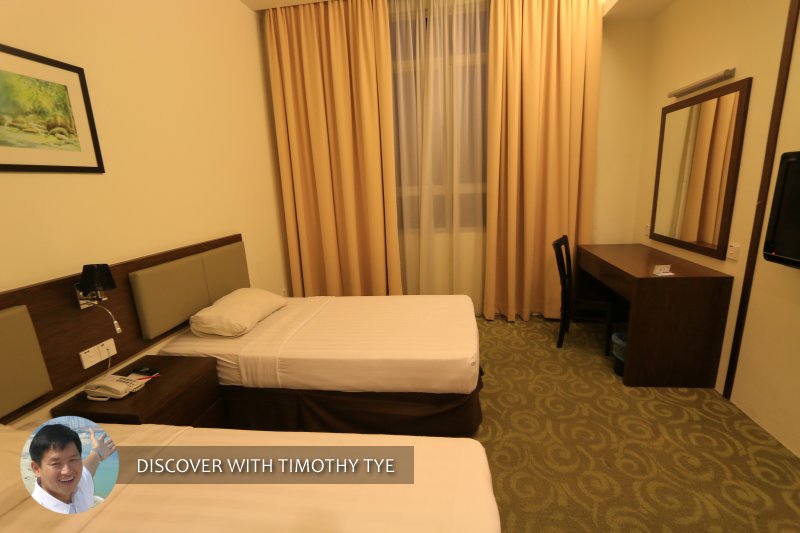 Seemsoon Hotel Ipoh (17 September, 2016)
Seemsoon Hotel Ipoh (17 September, 2016)
What to visit in Ipoh
There are so many places to visit when you're in Ipoh. In this introduction, I offer you just a few selections, with a longer list in the map section below.First stop, there's Taman Rekreasi Gunung Lang (GPS: 4.62745, 101.09056), a recreational park where you can engage in a wide variety of activities from boating to simply strolling.
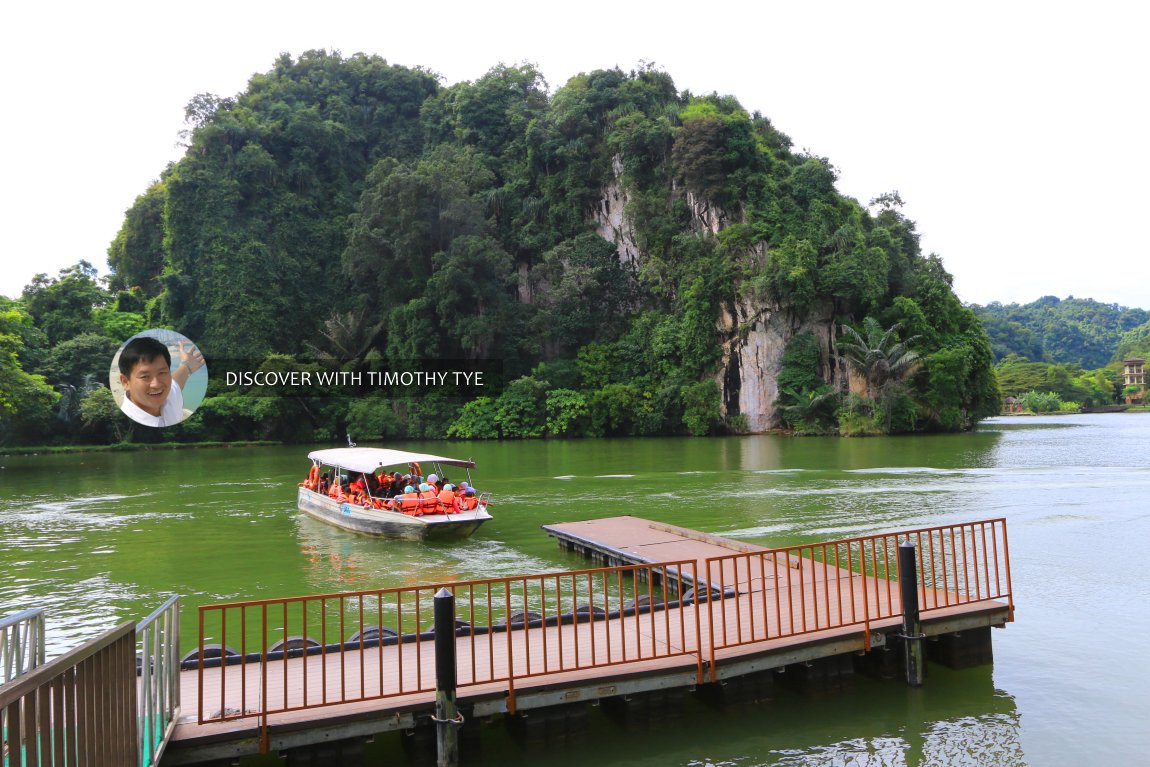 Boat ride at Taman Rekreasi Gunung Lang (9 November,m 2015)
Boat ride at Taman Rekreasi Gunung Lang (9 November,m 2015)
Located just north of Ipoh, it the suburb of Tambun, is a major waterpark called the Lost World of Tambun (GPS: 4.625816, 101.154768). It includes a hot spring and a spa.
Excursions from Ipoh
If you plan to make a short trip to Ipoh, do read day trips from Ipoh.Ipoh Cuisine
Ipoh is famous among the people of Malaysia for its food. Ipoh people claim that their water supply, which is relatively hard (high alkali content) owing to Ipoh's location on top of a large karstic formation, makes the food especially tasty.Ipoh is particularly famous for its "Sar Hor Fun", a flat white rice noodle. Folks from other towns often stop over in Ipoh to enjoy the dim sum if they arrive in the morning, and the nga choi kai, a dish of chicken and beansprouts, if they come in the evening. Ipoh's Hakka Mee and yong tau fee are also popular.
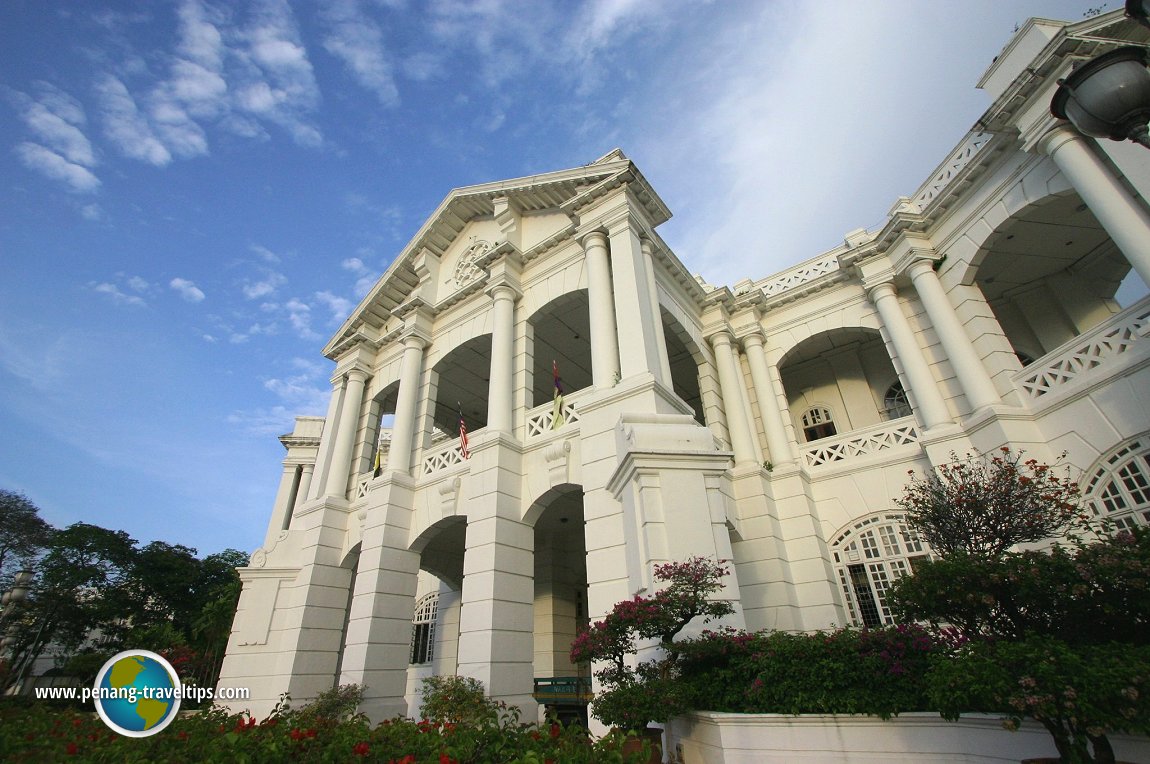 Dewan Bandaran Ipoh (18 September, 2005)
Dewan Bandaran Ipoh (18 September, 2005)
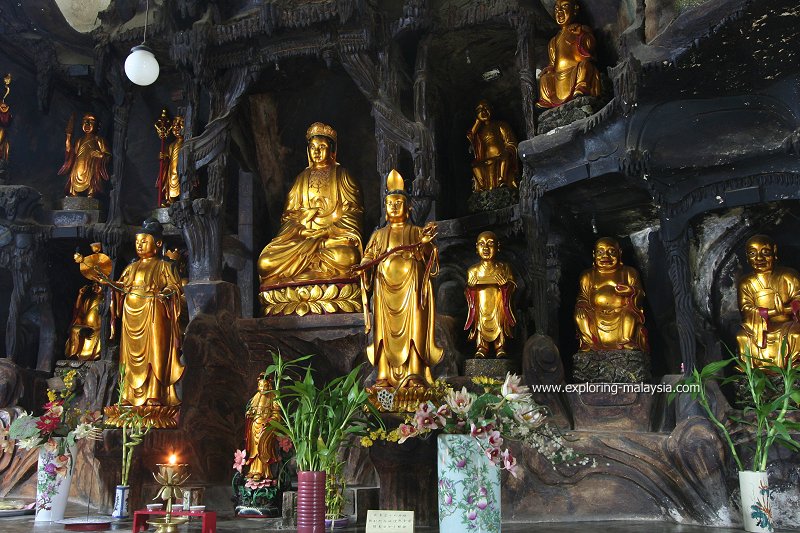 The interior of Nan Thien Tong, one of the cave temples in Ipoh (19 August 2006)
The interior of Nan Thien Tong, one of the cave temples in Ipoh (19 August 2006)
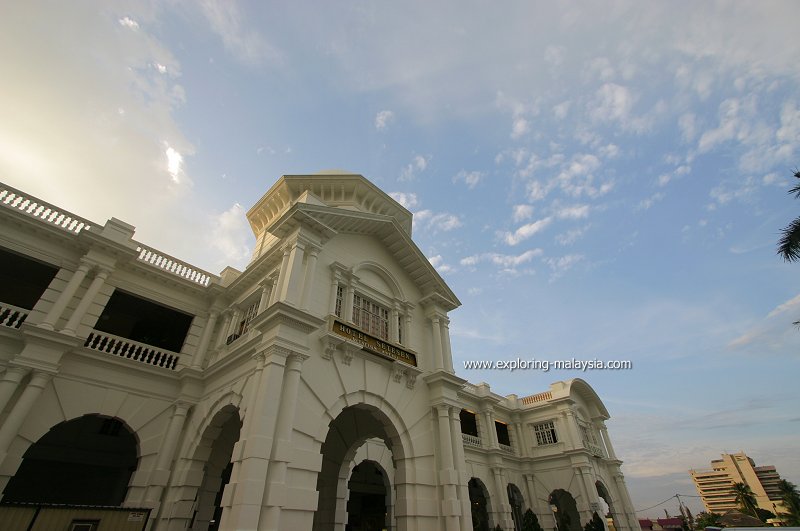 Ipoh Railway Station (18 September, 2005)
Ipoh Railway Station (18 September, 2005)
References
- Han Chin Pet Soo interpretive board on Ipoh timeline
- Benarkah Kampung Paloh dibuka oleh Hakka?
Back to Perak mainpage; list of Towns in Perak and State Capitals of Malaysia
 Latest updates on Penang Travel Tips
Latest updates on Penang Travel Tips
 Discover with Timothy Ipoh Videos
Discover with Timothy Ipoh Videos
Where to go, what to see when in Ipoh? Here are some suggestions with my videos! Ipoh Sight Index
Ipoh Sight Index
 Streets of Ipoh
Streets of Ipoh
 Map of Ipoh, Perak
Map of Ipoh, Perak

Copyright © 2003-2025 Timothy Tye. All Rights Reserved.

 Go Back
Go Back